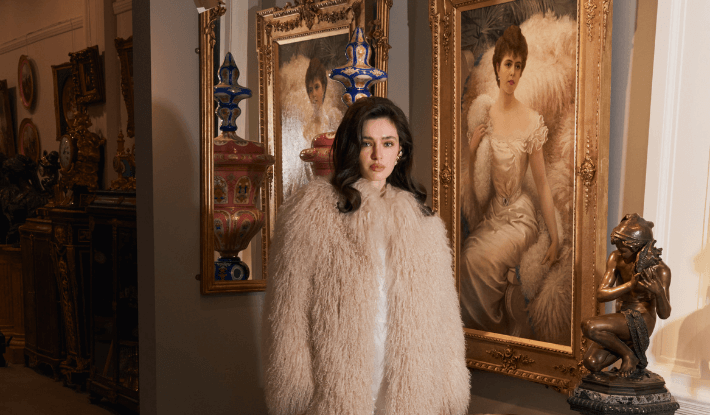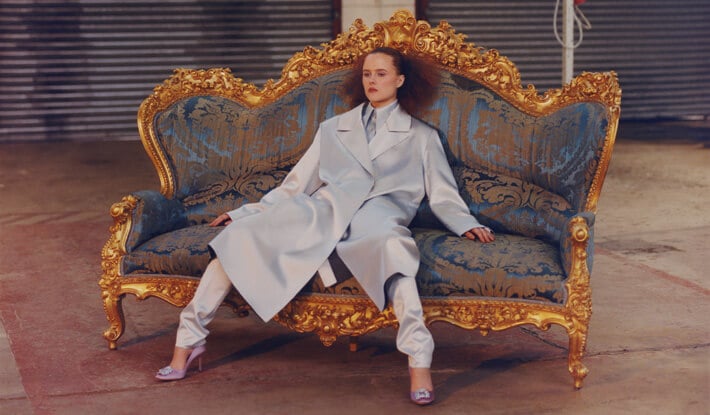The Second French Empire, also known as the era of Napoleon III (1852-1870), was a period of significant change in the world of design. Under the patronage of Napoleon III and his wife Empress Eugénie (1826-1920), the decorative arts flourished. Paris was transformed into a vibrant artistic centre, leading Europe in the development of new styles and techniques. The imperial couple were avid patrons of the arts, and their personal tastes had a profound influence on the styles of this era.
The design style of the period has long been characterised by a mixture of opulence, grandeur, and historicity, often portrayed as an era of decorative revival. Elements of Renaissance, Baroque, Rococo, and in particular Neo-Classical design history can be seen as having a profound influence on the art and architecture of the time. Yet, the period is also marked by significant technological and industrial advancements, which sparked innovations in design that adapted typical furniture to the rapidly modernising world. Let’s dive into the gilded world of 19th century antiques, to judge whether the decorative arts of this period were elegant historical revivals, or ingenious design innovations.
Revival and Return: The Rise of Napoleon III
Franz Xaver Winterhalter (German, 1805-1873), Portrait de l'empereur Napoléon III en pied (left), and L'Impératrice Eugénie (right), Early 19th Century. The emperor’s ascendancy to the throne of France was accompanied by significant changes to the decorative art world, as people looked back to the reign of his uncle, Napoleon I.
Napoleon III’s ascendency to the throne in 1848 was a historically significant moment in French history, bringing with it a sense of return. The country had seen its first ever presidential election, but the result was in many ways a return to the autocratic imperial figure, mirroring the sentiment felt decades earlier when Napoleon I (1769-1821) had come to the throne. France revelled in a newfound sense of nationalism and pride in its history, and the decorative arts followed suit – embracing earlier aesthetic trends, and reviving designs from the Gothic, Renaissance, Louis XV and Louis XVI periods.
The result was an opulent tapestry of diverse and eclectic design, which exuded grandeur, confidence and exceptional attention to detail. As the growing middle- and upper-classes began to commission grand furniture pieces to consolidate their standard of living, abundance and comfort became the hallmark of design. Sofas and armchairs were upholstered with luxurious fabrics like velvet and silk, and often embellished with tassels and fringes.
Napoleon III apartments in the Louvre: the epicentre of the Napoleonic establishment, it shows both extraordinary opulence, with a decorative style that is heavily ornamented, but also shows a concern for comfort, seen in the family-style upholstered sofas positioned convivially.
Revival and Return: Recalling Neo-Classicism
Alongside this prioritisation of comfort, Neo-Classical elements were particularly significant in the development of the decorative arts of the Second French Empire. As well as being the favoured style of the Empress Eugénie, this was largely a result of Napoleon III's fascination with the grandeur of the ancient world, especially the empires of Rome and Greece. The Neo-Classical style served as a conduit for expressing the stability, power, and imperial aspirations of the emperor’s reign, harking back again to the reign of his uncle Napoleon I, who aspired to renew the Roman Empire.
This large Napoleon III table draws upon classical mythology and Egyptian influence for its frieze decoration and lion feet.
In the field of furniture design, Neo-Classical elements were expressed through the use of straight lines, symmetrical forms, and classical motifs. Fluted columns, pediments, friezes, and classical ornamentations such as laurel wreaths, acanthus leaves, and Greek key patterns were prevalent. As part of this trend, artisans often combined rich materials like rosewood, walnut, and mahogany with intricate embellishments, for example, gilding, marquetry, and bronze ornamentation.
Cabinetmakers of the era, such as Charles-Guillaume Diehl (1811-1885) and Henry Dasson (1825-1896), incorporated the Neo-Classical motifs into their work, and using marble tabletops to lend a classical elegance to the furniture. So-called "Boulle" furniture, named after the cabinetmaker André-Charles Boulle (1642-1732), experienced a resurgence, featuring elaborate marquetry that often drew upon classical scenography, paired with gilt-bronze mountings.
The remarkably detailed marquetry panels of these two Boulle cabinets from the Royal Collection draw upon classical themes in their iconography and foliate decoration.
Textiles and wallpapers also harkened a Neo-Classical revival. Tapestries, carpets, and wallpapers featured classical scenes, landscapes, and motifs. Rich colours such as royal blue, crimson, and gold were frequently used, along with a large amount of ornamentation following the canons of the ancient civilisations, but also those reappropriated and adjusted by the early-19th century Empire style.
Ceramics and glassware too reflected these tastes. The renowned Sèvres Porcelain Manufactory, for instance, created pieces inspired by ancient pottery shapes, decorated with classical scenes and motifs. Glassmakers took inspiration from Roman cameo glass and Greek vase painting, producing pieces of remarkable craftsmanship and artistic ingenuity.
This Sèvres style trio of vases from the Mayfair Gallery collection employ foliate motifs as well as laurel wreaths, and the handles are cast in typical Classical style.
Innovation: Furniture Design in the Second Empire
However, the Second Empire was also marked by innovations in furniture design. As the industrial age swept Europe, craftsmen developed new techniques, and mass production of furniture made exceptional pieces available to the masses for the first time. New machines transformed the woodworking industry, enabling artisans to achieve unparalleled precision in veneer cutting. Gold-plating techniques gave ornamental bronzes an unmatched sheen, and advancements in tools made marble carving more intricate than ever before.
A famous invention of this era was the indiscreet three-person chair. The chair, designed to seat three individuals closely, was conceived to encourage intimate conversations, reflecting the bourgeoisie's penchant for private salons and close-knit gatherings. Its luxurious design and opulent materials underscored the rising affluence of its intended audience, who yearned for symbols of their newly acquired wealth and social status.
Encouraging intimate conversation in an opulent fashion, Indiscreets like the example above epitomized the bourgeoisie's societal norms and their desire for owning symbols of wealth and status.
Similar creativity was displayed by Antoine Krieger (1804-1869), the illustrious cabinetmaker, who introduced the world to ‘meubles à mécanisme’. These were furniture pieces that ingeniously incorporated special, often hidden mechanisms that transformed simple pieces into multi-purpose furniture or decorative items. This innovation was an ode to 18th-century furniture while integrating the technological marvels of the 19th century.
Alongside these technological innovations, there were also aesthetic developments that mark the period, one of which is the use of dark wood. Pieces of furniture would be painted with black lacquer, usually then decorated with finely detailed multi-coloured bouquets. Such items have become aesthetic staples of Napoleon III furniture, distinguishing it from earlier French periods.
The dining room in Napoleon III’s apartments in the Louvre – the use of dark wood in furniture that is enhanced by significant marquetry work is evident in the chairs and buffet.
Innovation: Wider Influences on the Second Empire
The decorative arts of the Second Empire period were also deeply influenced by oriental styles, partly due to France's colonial expansion. As France expanded its colonial empire during the 19th century, a plethora of ‘exotic’ materials, designs, and motifs began finding their way into French decorative arts. Items from North Africa, Southeast Asia, and the African continent introduced French designers and the public to new aesthetics.
Alongside the general trend of orientalism, the second half of the 19th century in France witnessed the rise of 'Japonisme’, a fascination with Japanese art and design. Japan opened its doors to international trade in the 1850s, leading to an influx of Japanese art and craft into Europe. Japanese screens, woodblock prints, ceramics, and lacquerware would become sources of inspiration for artists like Claude Monet (1840-1926) and Vincent van Gogh (1854-1890), as well as for decorative art producers. The clean lines, flat colour planes, and nature-inspired motifs of Japanese art found their way into everything from furniture and textiles to jewellery and graphic design in France.
East and West meet in this cabinet and stand, which combine Napoleon III style structures with decorative elements influenced by Japonisme.
Interior design was also influenced by contemporary architectural changes. Baron Haussmann's (1809-1891) renovation of Paris under Napoleon III's orders saw the construction of wide boulevards, squares and parks, and monumental buildings reflecting the grandeur of the Empire. The new buildings, featuring high ceilings and large windows, required furniture and decor that could fill the grand, bright spaces, creating a demand for oversized furniture and richly decorated interiors. The new green spaces and gardens that were constructed along the Parisian boulevards led to a preference for floral themes in the decorative arts to keep up with the vogue of the French capital.
The floral theme was prevalent in the decoration of wallpaper, vases, and furniture items.
The Legacy of the Second French Empire's Decorative Arts
It is easy to see how the Second Empire period has become known as the “style-without-style” – an eclectic mix of influence and innovation marks the design world at this time. The era is ultimately marked by this amalgamation between ‘revival and innovation’, rather than conforming to one or the other. Napoleon III period furniture combined the decorative elements of revival styles, in particular classicism, with modern elements that spoke to new technological invention, or Oriental influence, or even Hausmann’s Parisian architectural programme.
The changes during the era left a legacy that would alter decorative arts design and trade practices. A significant contribution was the increasing integration of art and industry. This period saw a growing acceptance of the use of industrialised processes in the creation of decorative items, enabling a higher number of pieces to be made in a shorter time, whilst still maintaining high aesthetic and craftsmanship standards. The industrialisation of the country played a crucial role in this change, bringing art out of the confines of the elite class and making it accessible to the burgeoning middle class. The democratization of art was a key factor that influenced future movements, such as Arts and Crafts and Art Nouveau.
Beyond the realm of design, the decorative arts of the Second French Empire also had socio-political implications. The period's eclectic styles reflected not just aesthetic preferences but also an era of political ambition, national identity, and cultural resurgence. The decorative arts became a tool for asserting France's cultural superiority on the global stage. During Napoleon III’s reign, France strived to reinforce its status as the epicentre of art, culture, and sophistication. This objective manifested in the country's decorative output, which celebrated French heritage while embracing and integrating global influences.
In retrospect, the decorative arts of the Second French Empire are not merely reflective of a particular time and place; they represent the confluence of art, politics, industry, and society. Their legacy is a testament to the enduring power of design to capture the zeitgeist of an era, influence future generations, and serve as a mirror to the aspirations and ideals of a nation.
Mayfair Gallery's collection of Second Empire antiques
As a gallery specialising in the very finest decorative art from France in the 19th century, we often have the pleasure of showcasing works from the Second Empire period. Explore the Napoleon III-style works in our collection here.
















